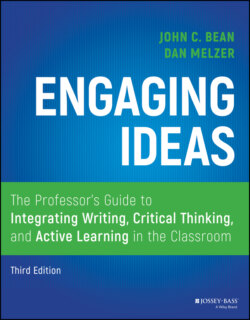Читать книгу Engaging Ideas - John C. Bean - Страница 39
Step 6: Develop Strategies for Teaching the Genres of Your Discipline and the Ways That These Genres Use Evidence to Support Claims
ОглавлениеInstructors in disciplinary courses hope not only to improve their students' critical thinking skills but also to teach them to think like disciplinary experts (to think like historians, psychologists, biologists, business managers, or nurses). To move from novice to expert in a given field, students must learn the discipline's ways of thinking, talking, and writing—what rhetoricians call the field's discourse community. Teachers can accelerate students' understanding of a field by designing assignments that teach students to write within the discipline's typical genres, such as experimental reports, ethnographies, recommendation memos, nursing care plans, design proposals, or field‐specific conference papers suitable for presentation at an undergraduate research conference.
In a prototype paper in many of these genres, the writer typically uses evidence from discipline‐specific primary sources or data to add something new, surprising, or challenging to a conversation carried on within the discipline's secondary sources: “Some scholars have said X (literature review), but I am arguing Y (thesis to be supported by analysis of appropriate primary sources or data).”
What undergraduates particularly need to learn is how different disciplines use different kinds of primary data for evidence. According to Richard Light (2001), “A surprising number of undergraduates describe learning how to use evidence to resolve controversies in their field, whatever their field, as a break‐through idea” (122). Light describes the bafflement of first‐year students as they shift from discipline to discipline, encountering different ways that disciplines gather and use evidence to address problems. Some disciplines derive their evidence from aural, visual, or verbal texts housed in libraries, historical archives, newspapers, art galleries, museums, or cyberspace. Other disciplines use evidence from lab or field research, often subjecting quantitative data to statistical analysis with results displayed in graphs or tables. Still other disciplines use qualitative data from observations of natural or cultural phenomena or from ethnographic notes, focus group transcripts, surveys, or interviews. Students need to see how these kinds of data serve as evidence to support an argument that joins a disciplinary conversation. Chapters 3 and 4, as well as chapter 10 on teaching undergraduate research, treat the use of disciplinary genres and evidence in more detail.
